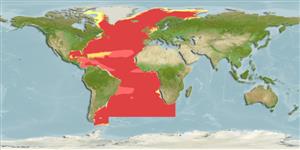>
Lophiiformes (Anglerfishes) >
Oneirodidae (Dreamers)
Etymology: Oneirodes: Greek, 'oneiros' = a dream or dreamlike or out of a dream (suggesting this fish is so strange and marvelous that can exist only in dreams) (Ref. 86949).
Environment: milieu / climate zone / depth range / distribution range
Ecologia
marino batipelagico; distribuzione batimetrica 0 - 1000 m (Ref. 5951). Deep-water
North Atlantic: single specimen from the Irminger Sea (Ref. 10523) and a single record from the eastern central Atlantic; also in the northwest Atlantic and western central Atlantic.
Size / Peso / Age
Maturity: Lm ? range ? - ? cm
Max length : 20.6 cm TL (female)
Short description
Chiavi di identificazione | Morfologia | Morfometria
Raggi dorsali molli (totale) : 6; Raggi anali molli: 4. Characterized by having esca with stout, internally pigmented anterior appendage less than half the length of escal bulb and bearing numerous tapering filaments at distal tip and 2-3 filaments along anterior margin; absence of medial escal appendages; terminal escal papilla truncated with two bilaterally placed distal pigment spots in specimens 20mm and larger; posterior escal appendage approximately one-half of escal bulb to longer than escal bulb in large specimens; distal one-third to one-half of posterior appendage split into numerous filaments; absence of lateral escal appendages; filamentous anterolateral escal appendage, less than length of anterior appendage; distal tips of filaments of anterior and posterior escal appendages and entire length of filaments of anterolateral escalappendage with dark melanophores in specimens 124mm and larger; relatively long and narrow subopercle, without indentation on posterodorsal margin; ventral fork length of opercle 24.4-26.0% SL; ratio of lengths of dorsal and ventral forks of opercle 0.46-0.53; absence of epibranchial teeth; presence of teeth on pharyngobranchial II; upper jaw teeth 26-70, lower jaw teeth 27-65; teeth on vomer 5-8; dorsal fin rays 6; anal fin rays 4; pectoral fin rays 15-17; head length 35.7-42.5% SL; head depth 32.2-45.0% SL; length of premaxilla 28.8-33.5% SL; length of lower jaw 39.9-47.5% SL; illicial length 23.8-40.2% SL (Ref. 86949).
Also mesopelagic (Ref. 10524).
Life cycle and mating behavior
Maturities | Riproduzione | Spawnings | Egg(s) | Fecundities | Larve
Bertelsen, E., 1990. Oneirodidae. p. 498-507. In J.C. Quero, J.C. Hureau, C. Karrer, A. Post, and L. Saldanha (eds.) Check-list of the fishes of the eastern tropical Atlantic (CLOFETA). JNICT, Lisbon; SEI, Paris; and UNESCO, Paris. Vol. 1. (Ref. 10524)
IUCN Red List Status (Ref. 130435)
Threat to humans
Harmless
Human uses
Strumenti
Special reports
Download XML
Fonti Internet
Estimates based on models
Preferred temperature (Ref.
123201): 0.5 - 17.1, mean 4.6 °C (based on 1541 cells).
Phylogenetic diversity index (Ref.
82804): PD
50 = 0.5000 [Uniqueness, from 0.5 = low to 2.0 = high].
Bayesian length-weight: a=0.01000 (0.00244 - 0.04107), b=3.04 (2.81 - 3.27), in cm total length, based on all LWR estimates for this body shape (Ref.
93245).
Trophic level (Ref.
69278): 4.2 ±0.7 se; based on size and trophs of closest relatives
Resilienza (Ref.
120179): Medio, tempo minimo di raddoppiamento della popolazione 1.4 - 4.4 anni (Preliminary K or Fecundity.).
Fishing Vulnerability (Ref.
59153): Low vulnerability (11 of 100).
